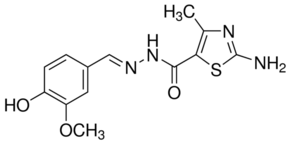All AbMole products are for research use only, cannot be used for human consumption.

For this product's availability, delivery time and price, please email [email protected] directly or click the "Inquiry Now" button below.
OM137 is an inhibitor of aurora kinases; inhibitor of spindle checkpoint. OM137 is an aminothiazole derivative, which functions to override the spindle checkpoint primarily through inhibition of the Aurora kinases (mitotic kinases). OM137 is a more potent inhibitor of Aurora B compared with Aurora A in vitro, consistent with the effects of OM137 on checkpoint function in living cells. The compound has some CDK1 inhibitory activity, but is likely that the major mode by which OM137 drives mitotic exit of cells arrested in M phase via the spindle checkpoint is through its inhibitory activity against Aurora B kinase. The compound is less potent than N-[4-[(6,7-Dimethoxy-4-quinazolinyl)amino]phenyl]benzamide hydrochloride (Sigma Cat. D6068), which is more suited for in vitro testing due to low solubility and high serum binding. OM137 is less potent than selective Aurora A inhibitor, cyclopropanecarboxylic acid {3-[4-(3-trifluoromethyl-phenylamino)-pyrimidin-2-ylamino]-phenyl}-amide (Sigma Cat. C2368).
| Molecular Weight | 306.34 |
| Formula | C13H14N4O3S |
| CAS Number | 292170-13-9 |
| Solubility (25°C) | DMSO: ≥10 mg/mL |
| Storage |
Powder -20°C 3 years ; 4°C 2 years In solvent -80°C 6 months ; -20°C 1 month |
| Related Products |
|---|
| DSPE-PEG-FA
DSPE-PEG2K-FA is a PEG derivative containing folic acid. DSPE-PEG2K-FA has a targeting effect and can bind to folic acid receptors in cancer cells. DSPE-PEG2K-FA forms micelles/lipid bilayers and can be used in research on targeted drug delivery systems. |
| Lifastuzumab
Lifastuzumab is a humanized anti-NaPi2b IgG1 monoclonal antibody. |
| GPVI antagonist 1
GPVI antagonist 1 is a glycoprotein VI (GPVI) platelet receptor antagonist. GPVI antagonist 1 inhibits collagen-induced platelet aggregation with an IC50 of 25.3 μM. |
| MPSD TFA
MPSD TFA (MARCKS-ED TFA) is a 25-amino acid peptide based on the effector domain sequence of the intracellular membrane protein myristoylated alanine-rich C-kinase substrate (MARCKS). MPSD TFA can sense membrane curvature and recognize phosphatidylserine. MPSD TFA can be utilized as biological probe to study membrane shape and lipid composition. |
| 4-Nitro-2,1,3-benzoselenadiazole
4-Nitro-2,1,3-benzoselenadiazole is a biochemical material that can be used in scientific research. |
All AbMole products are for research use only, cannot be used for human consumption or veterinary use. We do not provide products or services to individuals. Please comply with the intended use and do not use AbMole products for any other purpose.


Products are for research use only. Not for human use. We do not sell to patients.
© Copyright 2010-2024 AbMole BioScience. All Rights Reserved.
